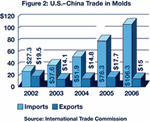New Economic Stimulus Law Should Help Boost Sales
This year’s $168-billion economic stimulus package, as crafted by both the Administration and Congress, is designed to be “timely, targeted and temporary”—which essentially means that its tax incentives, which are the heart of the package, are good for 2008 only. But the incentives offer something for just about everyone this year. Individual taxpayers are expected to see rebate checks and for American businesses, the new law contains business tax provisions that are perhaps the most important in terms of economic stimulus.
They come in two forms: 1) 50 percent bonus depreciation for new capital expenditures (like equipment) ordered and put into service during 2008; and 2) a boost in how much small businesses can write off—called Section 179 expensing—for 2008 new and used equipment purchases.
Both of these provisions have the potential for boosting both equipment sales, which is great for the producers, and business purchases, which is great for the buyers—particularly in the case of smaller companies that might otherwise be skittish about making capital purchases during an uncertain economic year.
50 Percent Bonus Depreciation
Bonus Depreciation allows businesses an extra one-year boost in how much they can deduct on capital expenditures that they normally would depreciate over a period of time. It only applies, however, to new equipment that is bought and put into service during 2008.
Example: Company X buys a $100,000 piece of equipment that it normally would depreciate over seven years, at a first-year depreciation rate of 14 percent. Under the new 50 percent bonus depreciation, Company X can automatically deduct $50,000 (50 percent) of the cost of equipment right off the top. In addition to that bonus, the company can then calculate and deduct the 14 percent first-year rate on the remaining basis of the property. As a result, instead of only being able to deduct $14,000 for 2008 on its equipment purchase, Company X gets to deduct $50,000 plus $7,000 (14 percent of the remaining basis)—for a total, first-year write-off of $57,000.
Increased Section 179 Expensing for Small Businesses
The new law also boosts the amount that small businesses can write off for new or used equipment purchased during 2008—from $128,000 to $250,000. Additionally, the law increases the total amount that can be purchased during the year and still receive the full benefits of the Section 179 expensing option—from the previous cap of $510,000 to $800,000. Moreover, the 50 percent bonus depreciation can then be taken on the remaining basis of the equipment if it is new.
Example: Company X buys a new $400,000 machine during 2008. Instead of being able to write off only $166,080 for the 2008 tax year on this purchase ($128,000 under Sec. 179 plus regular first-year depreciation), it can now write off $335,500 ($250,000 under Sec. 179, plus $75,000 for bonus depreciation and $10,500 in regular first-year depreciation.)
It's too soon to know just how much bang for the buck these economic stimulus provisions ultimately will provide to the manufacturing technology industry. But if past is prologue, they should help create a bounce in sales and purchases in much the same way that a similar 50 percent bonus depreciation did that was enacted temporarily in 2003.
![]()
Related Content
-
Top 10 Topics to Cover During an ISO 9001 Manufacturing Audit
Take a look at this practical hands-on approach to conducting a quality audit.
-
The Critical Role of Management Representatives in ISO 9001
In ISO 9001 quality management systems, the Management Representative (MR) plays a crucial role. While the 2015 version of ISO 9001 no longer mandates this position, having a trusted management member serve as an MR remains vital for streamlining operations and maintaining quality standards.
-
Mold Design Review: The Complete Checklist
Gerardo (Jerry) Miranda III, former global tooling manager for Oakley sunglasses, reshares his complete mold design checklist, an essential part of the product time and cost-to-market process.













